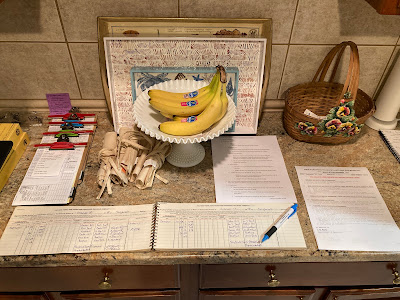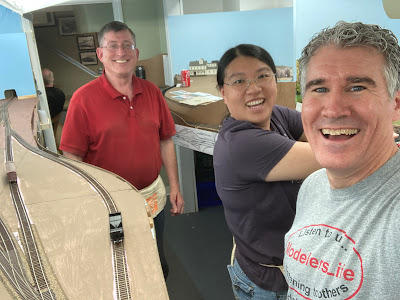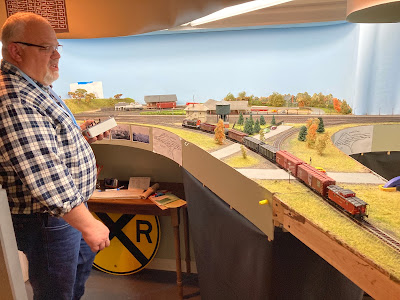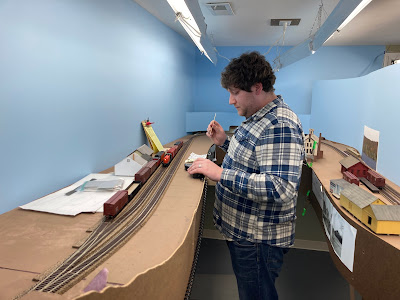 |
| Photographer, Date, Location Unknown |
As I mentioned last week, the Atlas S-2 with horizontal louvers provides a great start to modeling the first nine New Haven DEY-5 class switchers (0600-0608). And as I mentioned yesterday, the main visual changes will be to add a new cab and a different horn/whistle. But there are a couple of - thankfully minor - issues with the model itself. . .
The first thing I noticed "wrong" with the Atlas S-2 right out of the box was the position (and brightness!) of the headlight:
(Disclaimer - Most of this post first appeared 9/23/2018)
Like many of you, one of the first things to do before starting any modeling project is something I find the most fun - research. So, as I begin modeling the New Haven's Alco S-2s and S-1s (class DEY-5 and DEY-3, respectively), I want to get all my modeling notes together in one place - and put them here for any of you that may want to try modeling these locos yourself (or just curious about the history...)
 |
| New Haven class DEY-3 switcher #0967 with Valley Local freight at Fernwood Street, Wethersfield, CT in 5/1949. John Wallace photo. |
The first stop when researching any New Haven railroad locomotives is Jack Swanberg's seminal work New Haven Power, which provides encyclopedic coverage of all NHRR motive power throughout the history of the railroad. You'll also want to be sure and consult the series of books produced by Bob Liljestrand (Bob's Photos) that have covered NH engines. Volume 1 covers the switchers and road switchers, including the DEY units.
Marc Frattasio and Bill Chapin aggregated a ton of prototype information and provided the definitive resource for the DEY-3 and DEY-5 switchers in the Volume 35, Issue 1 edition of the NHRHTA's Shoreliner magazine.
Since I'm modeling both types of engines (DEY-3 #0967 for the Valley Local & DEY-5 #0604 for the Haddam Local, aka PDX-2), I figured a quick reference of prototype information would be helpful to repost here. And if you have any interest in these engines, I hope you find these notes helpful too. But for the most comprehensive information, including lots of photos, be sure to consult the Shoreliner article and the books mentioned above.
 |
| Image from NHRHTA Photo Library |
The New Haven's DEY-3 and DEY-5 class switchers differed visually from standard Alco S-1s and S-2s in two primary respects:
 |
| Instead of a standard air horn, the New Haven used brass (or bronze?) 3-chime air whistles. Image from the Shoreliner article. |
Classification System & Number Series
In addition to the DEY-class diesel switchers I'm working on lately, long-time readers know I've also had a J-1 class 2-8-2 on my workbench for years. Literally. In fact, converting this 40 year old Key Imports brass model into New Haven RR #3022 first showed up on my annual goals list way back in January, 2017 (yikes! over 5 yrs ago...).
Other than converting it to DCC, the major change to the model involves converting the tender to a "clear vision" version, just like the prototype did. As you'll see in the videos below, the major part of that work is done (and, actually, has been for a long time). I've also been puttering around on some other detail work - or was, before I started on the Alco switchers.
I'll definitely have more to say - and show - on this locomotive in future posts, especially once it makes its way from the back of the bench to the front. But the switchers have to be done first and in the meantime, I'll content myself with watching this ancient model still running smoothly on straight DC (yes, the "Airline" part of my layout converts from DCC to DC with the flick of a switch. If anybody's interested in learning how, let me know in the comments and I'll do a post on it).
Enjoy - and have a great weekend!
(Disclaimer - much of this post first appeared 1/5/2018)
Based on its early success with Alco's diesel switchers during the 1930s (the famed "High Hoods"), the New Haven Railroad rostered an impressive number of Alco's successor models - the S-1 & S-2. Deliveries started in 1941 and continued to 1949 for a total of 87 units.
These switchers had essentially the same prime mover as the HH660 (a 660hp McIntosh & Seymour Model 531), but while the engine was mounted above the frame on the High Hood locos (which is why the hoods were "high"), on the S-1 the same engine (now designated Model 539) was mounted down in the frame to lower the hood and increase crew visibility. Other than some cosmetic differences (different exhaust stack, larger radiator louvers), the S-2 was essentially the same as the S-1 but had a turbocharged version of the 539 engine (designated 539T) that increased the horsepower from 660hp to 1000hp. In 1943, the railroad began taking delivery of Alco S-2s and the "DEY" classification started the following year, with delivery of the last of 22 S-2s (#0600-0621). S-1s (class DEY-3) would continue to be delivered until January 1949 for an impressive total of 65 units (#0931-0995).In the Connecticut Valley of 1948/49, the local freights were powered primarily by DEY-3 and 5 class switchers (Alco S-1s and 2s). Unfortunately (depending on your perspective), the New Haven's Alco S-1s and 2s had a special low-profile cab.
So, I got an undec Atlas S-2 and am converting it into NH DEY-5 #0604 (I also have a Proto2000 undec S-1 waiting for a decoder and Scale Sound Systems speaker before being converted into the Valley Local's #0967). If you've been a regular reader, you've seen occasional progress posts - usually for Wordless Wednesday. But starting today, I plan to do a more-thorough step-by-step series of posts showing how I went from unit you see above to (hopefully) something close to what you see below . . .
Wow - I really have to get myself organized. Probably like many of you, I have photos, music files, documents, and all sorts of digital detritus scattered across multiple devices, computers, both real and virtual, local, and in the cloud. I'm really hoping my buddy Randy can help me get everything cleaned up and into one place soon, but in the meantime... well, let's just say the struggle is real . . .
Case in point: turns out, despite the fear I mentioned yesterday, I actually DO have photos from my ops session last October! Unfortunately, I don't actually remember much about that session (I only recall a couple of minor trackwork issues), but I DO remember it being a Special Saturday Session for some Out-of-Staters as well as a couple of newcomers to the Valley Line!
So, without further ado, I'll let the photos tell the story . . .
 |
| The major improvement since the last session was some scenery and backdrop at Dividend. |
 |
| I usually get a shot of the nicely organized paperwork and operator's desk. It looks so nice... until chaos ensues. |
 |
| Speaking of paperwork - I decided to try moving it, along with the sign-in book, upstairs to the kitchen since it can get a bit crowded at the bottom of the basement stairs. |
 |
| But turned out, not everybody signed in upstairs - so back downstairs it came, where folks are used to signing in right before they get their train. |
 |
| And what folks are we talking about? Wow - what folks they were! Here's Mark Herrick, fellow AML-er - who I just met in person at last Autumn's NER Convention- operating here for the first time, and veteran operator Jim Lincoln (of "Jim Lincoln Chev-Olds" fame). Mark came all the way from the northeastern corner of the state and Jim came in from Massachusetts to operate the Valley Local. Here they are with the local in Wethersfield. |
 |
| Regulars Tom and Kaylee working Shore Line west staging and the Airline local, respectively. |
 |
| Alex, another first-timer (and super helpful in helping solve my shorting issues), worked with Chris on PDX-2 with Tom and Kaylee looking on... |
 |
| Kinda like this - Jim was the only crew on PDX-1 and look at all the room he has here in Saybrook! |
 |
| And whither the Valley Local? We catch them here in the Dividend section of Rocky Hill, switching Hartford Rayon. |
 |
| Alex and Chris back in Saybrook after their run up the Valley branch to East Haddam & back, dropping & picking cars before they continue west to Cedar Hill Yard. |
 |
| More smiles in Middletown - Kaylee's Airline Local is ready to head back down to Cedar Hill while Jim & Mark finish their switching so they can head back north to Hartford. |
 |
| One of the best things about my occasional Saturday Sessions is not only the opportunity to open up the layout to out-of-staters that would otherwise not be able to operate here, but to be able to go out for dinner together afterwards. And where else could be better than right along the Shore Line in Saybrook in the old freight house? Here we are at Pizza Works getting some well-deserved sustenance after a "hard day's work" operating the Valley Line. |
This'ere blog has had some fits and spurts lately fer sure...
2022 started out fine enough, with a lot of posts going into the first half of January (see here).
Then it diminished to a LONG update post at the end of January (see here). Thankfully, it was a long post because I'd actually done a lot of modeling and work on the layout but hadn't posted about it. Well, I'd done regular little posts on the Valley Local Facebook Group - but many of you here are not there.
Since the end of January, legislative session started and work got busy. Thankfully though, I've still been able to do some modeling and such - and I had an an ops session!
I've only hosted 3 sessions since the big Pre-Springfield AML session of January 23, 2020 BC (before COVID) - July, September, and October, 2021. While I posted reports for the first two (click on the links), sadly, I forgot to take pics during the October session. That's especially disappointing since that session featured two newbies to the Valley Local - Mark Herrick and Alex Wood! Kaylee Zheng, Chris Zygmunt, Jim Fellows, Jim Lincoln, and regulars Tom Derwin, Bill Schneider, and Bob Murphy attended as well. I'm REALLY hoping one of them may have taken photos (and will let me know!)
So yeah - I've been a bit spotty with posting, but hope to slowly work my way out of that rut . . . starting with a quick report of the most-recent ops session, and the first one since last October!
The February session was another shake-down of sorts, since shorting issues have continued to bedevil me over the past few months. But thankfully, I seem to have FINALLY solved the problem. If you're interested, I'll go into more detail in a future post, but suffice it to say I needed to 1) upgrade my PSX circuit breakers, and 2) increase their trip delay by 30ms vs. the PSX reversers.
Confident I'd finally fixed things, I had some of my regulars over to put the layout through its paces. Randy, Tom, Bill, Pieter, Kaylee, Bob, and Chris ran all four local freights as well as the Shore Line trains. And I'm pleased to be able to report that everything ran really well! Well, the Shore Line trains continue to be a little finicky over the West End Loop (blame full-length passenger equipment on a 24" radius turnback curve), and a few decoder programming issues manifested themselves, but all in all, I consider it a success!
Heh - I think I may actually dare to run a full-steam session next time...
 |
| Randy working The Valley Local (HDX-7) in Middletown Yard. |
 |
| Tower operator Bill supervising Pieter running The Shore Line local (PDX-1) while Tom (New Haven staging/Shore Line trains) looks on. |
 |
| Kaylee switching the Airline Local in the freelanced town of Somerset. Note she's using the ProtoThrottle to operate DERS-2 #0510. |
 |
| Chris operating The Haddam Local(aka westbound Shore Line local, aka PDX-2) in East Haddam. |
 |
| Kaylee and Randy with their locals meeting in Middletown, just like the prototype. |